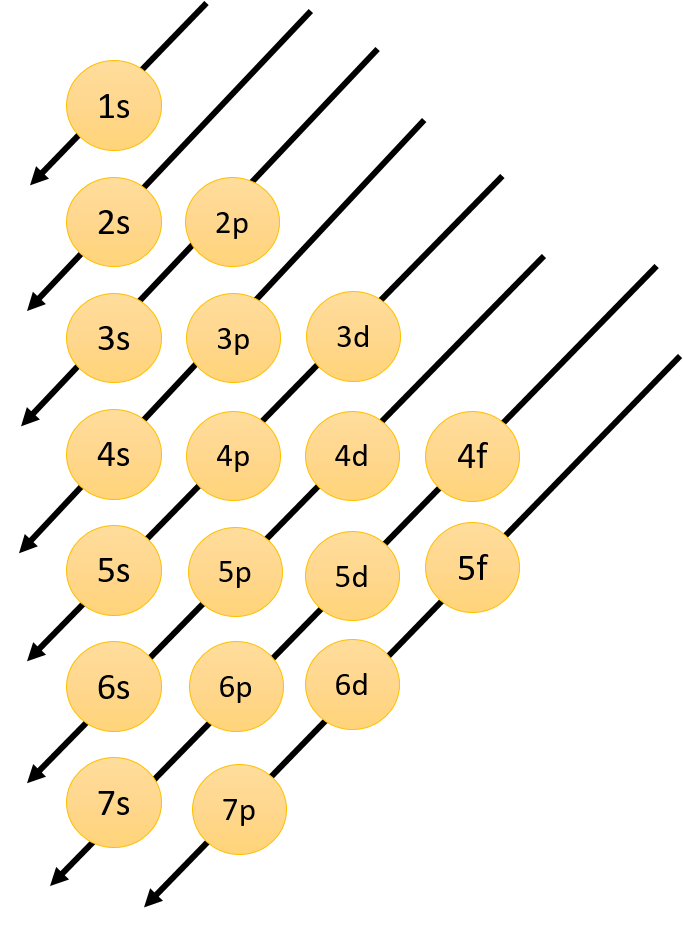
In potassium, the order of energy levels is:
(A) $3s > 3d$
(B) $4s < 3d$
(C) $4s > 4p$
(D) $4s = 3d$
Answer
225k+ views
Hint: The electronic configuration of potassium is $[Ar]4{s^1}$. Aufbau principle states that in the ground state of atoms, the orbitals are filled in the order of their increasing energies.
Complete step by step solution:
According to the Aufbau principle, the electrons first occupy the lowest energy orbital available to them and enter into higher energy orbitals only when the lower energy orbitals are filled. The order in which the energies of the orbitals increase and also the order in which the orbitals are filled are $1s,2s,2p,3s,3p,4s,3d,5s,4d,5p,6s,......$
This can be easily understood by the following diagram:

The energy of the orbitals depends upon the principal quantum number ($n$) and azimuthal quantum number ($l$). Orbital energy increases as ($n + l$) increases. So lower the value of ($n + l$) for an orbital, the lower is its energy. If there are two orbitals with the same value of ($n + l$) the one with the smaller value of $n$ has the lower energy.
Therefore a subshell with a lower value of ($n + l$) possess lower energy and is filled first. Let us consider $4s$ and $3d$ subshell.
For $4s$ subshell, $n + l = 4 + 0 = 4$,
while for 3d subshell, $n + l = 3 + 2 = 5$.
Hence, the ($n + l$) value of $4s$ subshell is lower than that of $3d$ subshell, so its energy is lower than that of $3d$ subshell. Thus, the $4s$ subshell is filled before the $3d$ subshell.
In the case of potassium ($K$) (atomic number ($Z$) =$19$), the electronic configuration is $1{s^2}2{s^2}2{p^6}3{s^2}3{p^6}4{s^1}$. From the electronic configuration, it can be observed that the last electron of the potassium entered into the $4s$ subshell instead of the $3d$ subshell. This is because the energy of $4s$ subshell is lower than that of $3d$ subshell as illustrated above.
Hence, option (B) is the correct answer.
Note: The energies of different orbitals drop to a different extent with an increase in atomic number because of the effective nuclear charge. The half-filled and completely filled subshells possess extra stability due to the symmetrical distribution of electrons and greater exchange energy. That is why the electronic configuration of some elements are exceptional and not in accordance with the normal order of filling. E.g., Cr ($Z = 24$) and Cu ($Z = 29$).
Complete step by step solution:
According to the Aufbau principle, the electrons first occupy the lowest energy orbital available to them and enter into higher energy orbitals only when the lower energy orbitals are filled. The order in which the energies of the orbitals increase and also the order in which the orbitals are filled are $1s,2s,2p,3s,3p,4s,3d,5s,4d,5p,6s,......$
This can be easily understood by the following diagram:

The energy of the orbitals depends upon the principal quantum number ($n$) and azimuthal quantum number ($l$). Orbital energy increases as ($n + l$) increases. So lower the value of ($n + l$) for an orbital, the lower is its energy. If there are two orbitals with the same value of ($n + l$) the one with the smaller value of $n$ has the lower energy.
Therefore a subshell with a lower value of ($n + l$) possess lower energy and is filled first. Let us consider $4s$ and $3d$ subshell.
For $4s$ subshell, $n + l = 4 + 0 = 4$,
while for 3d subshell, $n + l = 3 + 2 = 5$.
Hence, the ($n + l$) value of $4s$ subshell is lower than that of $3d$ subshell, so its energy is lower than that of $3d$ subshell. Thus, the $4s$ subshell is filled before the $3d$ subshell.
In the case of potassium ($K$) (atomic number ($Z$) =$19$), the electronic configuration is $1{s^2}2{s^2}2{p^6}3{s^2}3{p^6}4{s^1}$. From the electronic configuration, it can be observed that the last electron of the potassium entered into the $4s$ subshell instead of the $3d$ subshell. This is because the energy of $4s$ subshell is lower than that of $3d$ subshell as illustrated above.
Hence, option (B) is the correct answer.
Note: The energies of different orbitals drop to a different extent with an increase in atomic number because of the effective nuclear charge. The half-filled and completely filled subshells possess extra stability due to the symmetrical distribution of electrons and greater exchange energy. That is why the electronic configuration of some elements are exceptional and not in accordance with the normal order of filling. E.g., Cr ($Z = 24$) and Cu ($Z = 29$).
Recently Updated Pages
JEE Main 2026 Session 1 Correction Window Started: Check Dates, Edit Link & Fees

JEE Isolation, Preparation and Properties of Non-metals Important Concepts and Tips for Exam Preparation

Isoelectronic Definition in Chemistry: Meaning, Examples & Trends

Ionisation Energy and Ionisation Potential Explained

Iodoform Reactions - Important Concepts and Tips for JEE

Introduction to Dimensions: Understanding the Basics

Trending doubts
JEE Main 2026: City Intimation Slip and Exam Dates Released, Application Form Closed, Syllabus & Eligibility

JEE Main 2026 Application Login: Direct Link, Registration, Form Fill, and Steps

Understanding the Angle of Deviation in a Prism

How to Convert a Galvanometer into an Ammeter or Voltmeter

Hybridisation in Chemistry – Concept, Types & Applications

Ideal and Non-Ideal Solutions Explained for Class 12 Chemistry

Other Pages
JEE Advanced Marks vs Ranks 2025: Understanding Category-wise Qualifying Marks and Previous Year Cut-offs

Thermodynamics Class 11 Chemistry Chapter 5 CBSE Notes - 2025-26

Organic Chemistry Some Basic Principles And Techniques Class 11 Chemistry Chapter 8 CBSE Notes - 2025-26

JEE Advanced 2026 - Exam Date (Released), Syllabus, Registration, Eligibility, Preparation, and More

JEE Advanced 2026 - Exam Date (Released), Syllabus, Registration, Eligibility, Preparation, and More

Hydrocarbons Class 11 Chemistry Chapter 9 CBSE Notes - 2025-26




